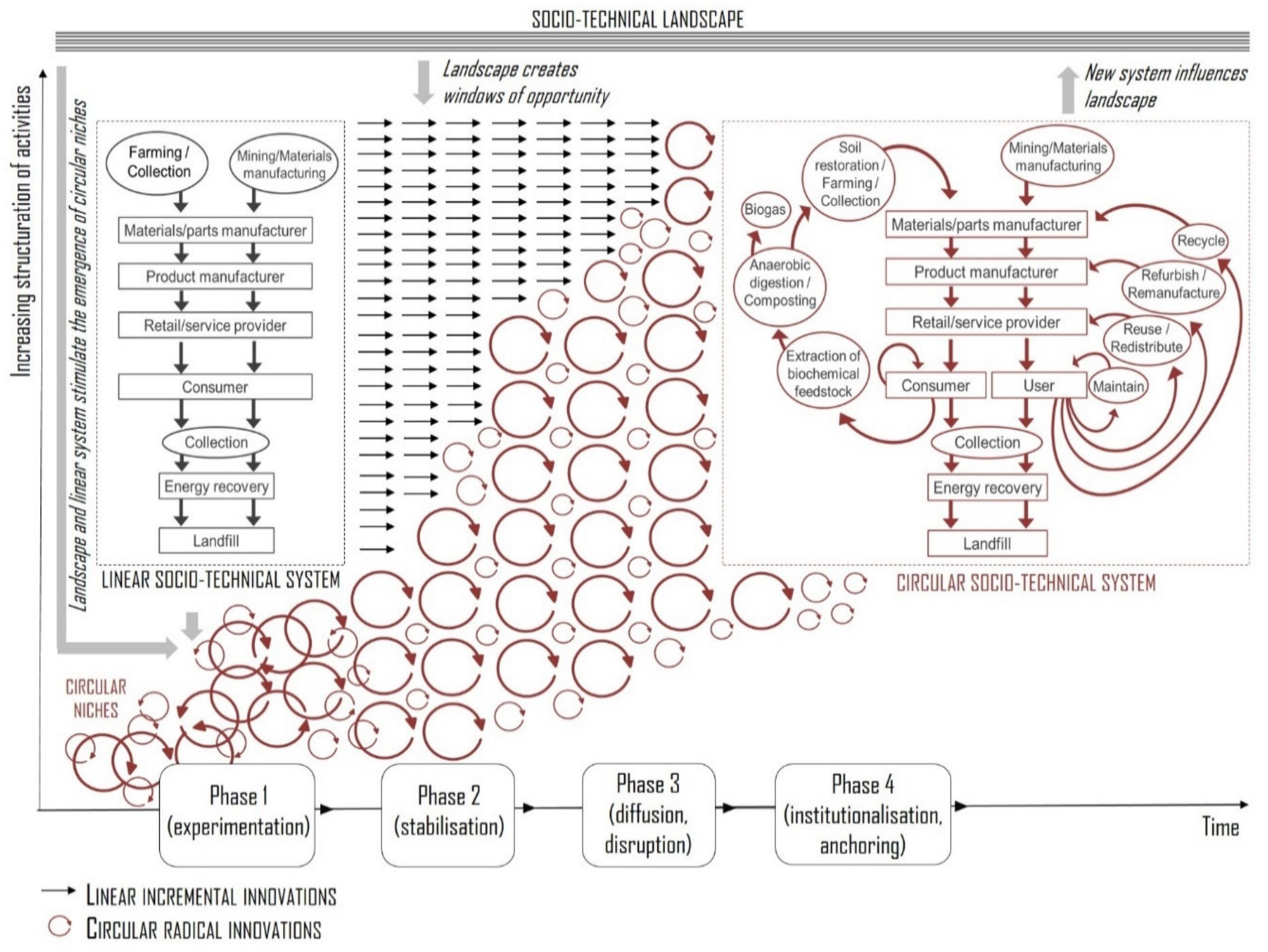Three Propositions to Unify Circular Economy Research: A Review
Abstract
1. Introduction
- i.
- CE gathers the principles of other schools of thought and elaborates them in a narrative able to inspire policy actions.
- ii.
- CE is evoking a socio-technical transition into multiple regimes in which societal and material needs are fulfilled by innovative industrial systems.
- iii.
- CE contributes to the environmental and economic dimensions of sustainability by means of an eco-effectiveness approach to industrial systems.
2. From Many Schools of Thought to a Unified Narrative Able to Inspire Policy Change
3. Transitioning Into Multiple Circular Socio-Technical Systems
- N (Limit to subject area): applying this filter to Scopus, the refined outcome includes articles belonging also to other subject categories than the one at hand
- N (Exclude other subject areas): applying this filter to Scopus, the refined outcome includes articles belonging only to the subject category at hand
- Total: the total number of articles corresponding to the Scopus search “circular economy” in the field “Article title, Abstract, Keywords”
4. From Eco-Efficiency to Eco-Effectiveness to Foster Sustainability
5. Discussion
“Future research should explore how to specify better, improve, or complement the guiding principles of a CE because these are the constant reference points to inspire and orient actions of the framework. As theoretical core statements of a proposition, guiding principles must be clearly defined, consistent, and comprehensive. In a world dominated by buzzwords and dissonant meanings, clarity in language and consistent definitions of terms (not just in industrial ecology and sustainability discourse) are imperative to avoid misinterpretation, while facilitating effective implementation of frameworks like the CE one.”
6. Conclusions
Author Contributions
Funding
Conflicts of Interest
References
- Ghisellini, P.; Cialani, C.; Ulgiati, S. A review on circular economy: The expected transition to a balanced interplay of environmental and economic systems. J. Clean. Prod. 2016, 114, 11–32. [Google Scholar] [CrossRef]
- EMF (Ellen MacArthur Foundation). Achieving ‘Growth Within; Ellen MacArthur Foundation: Isle of Wight, UK, 2017. [Google Scholar]
- Schröder, P.; Anggraeni, K.; Weber, U. The Relevance of Circular Economy Practices to the Sustainable Development Goals. J. Ind. Ecol. 2018, 23, 77–95. [Google Scholar] [CrossRef]
- Zwier, J.; Blok, V.; Lemmens, P.; Geerts, R.-J. The Ideal of a Zero-Waste Humanity: Philosophical Reflections on the Demand for a Bio-Based Economy. J. Agric. Environ. Ethic 2015, 28, 353–374. [Google Scholar] [CrossRef]
- Kerdlap, P.; Low, J.S.C.; Ramakrishna, S. Zero waste manufacturing: A framework and review of technology, research, and implementation barriers for enabling a circular economy transition in Singapore. Resour. Conserv. Recycl. 2019, 151, 104438. [Google Scholar] [CrossRef]
- Steffen, W.; Crutzen, P.J.; McNeill, J.R. The Anthropocene: Are Humans Now Overwhelming the Great Forces of Nature. Ambio 2007, 36, 614–621. [Google Scholar] [CrossRef]
- Eiroa, B.S.; Fernández, E.; Méndez, G.; Soto-Oñate, D. Operational principles of circular economy for sustainable development: Linking theory and practice. J. Clean. Prod. 2019, 214, 952–961. [Google Scholar] [CrossRef]
- Xu, F.J. The Studies of the Concept Plan of the Fengcheng Industrial Park towards the Circular Economy. Adv. Mater. Res. 2012, 598, 220–223. [Google Scholar] [CrossRef]
- Merli, R.; Preziosi, M.; Acampora, A. How do scholars approach the circular economy? A systematic literature review. J. Clean. Prod. 2018, 178, 703–722. [Google Scholar] [CrossRef]
- EMF (Ellen MacArthur Foundation). Delivering the Circular Economy-A Toolkit for Policy Makers; EMF (Ellen MacArthur Foundation): Isle of Wight, UK, 2015. [Google Scholar]
- Bocken, N.; De Pauw, I.; Bakker, C.; Van Der Grinten, B. Product design and business model strategies for a circular economy. J. Ind. Prod. Eng. 2016, 33, 308–320. [Google Scholar] [CrossRef]
- Lewandowski, M. Designing the Business Models for Circular Economy—Towards the Conceptual Framework. Sustain. 2016, 8, 43. [Google Scholar] [CrossRef]
- Camacho-Otero, J.; Boks, C.; Pettersen, I.N. Consumption in the Circular Economy: A Literature Review. Sustain. 2018, 10, 2758. [Google Scholar] [CrossRef]
- Kirchherr, J.; Piscicelli, L.; Bour, R.; Kostense-Smit, E.; Muller, J.; Huibrechtse-Truijens, A.; Hekkert, M. Barriers to the Circular Economy: Evidence From the European Union (EU). Ecol. Econ. 2018, 150, 264–272. [Google Scholar] [CrossRef]
- Sandoval, J.V.P.; Jaca, C.; Ormazabal, M. Towards a consensus on the circular economy. J. Clean. Prod. 2018, 179, 605–615. [Google Scholar] [CrossRef]
- Skene, K.R. Circles, spirals, pyramids and cubes: Why the circular economy cannot work. Sustain. Sci. 2017, 13, 479–492. [Google Scholar] [CrossRef]
- Mc Donough, W.; Braungart, M. Cradle to Cradle: Remaking the Way We Make Things; North Point Press: New York, NY, USA, 2002. [Google Scholar]
- Sharfman, M.; Graedel, T.E.; Allenby, B.R. Industrial Ecology. Acad. Manag. Rev. 1995, 20, 1090. [Google Scholar] [CrossRef]
- Benyus, J.M. Biomimicry: Innovation Inspired by Nature; Harper Collins: New York, NY, USA, 2002. [Google Scholar]
- Commoner, B. The Closing Circle: Nature, Man, and Technology. Random House Inc: New York, NY, USA, 1971. [Google Scholar]
- Stahel, W.R.; Reday, G. The potential for substituting manpower for energy; report to DG V for Social Affairs; Commission of the EC: Brussels, Belgium, 1976. [Google Scholar]
- Stahel, W.R. The Performance Economy; Springer: Berlin/Heidelberg, Germany, 2010. [Google Scholar]
- Pauli, G.A. The Blue Economy: 10 Years, 100 Innovations, 100 Million Jobs; Paradigm Publications: Boulder, CO, USA, 2010. [Google Scholar]
- Lyle, J.T. Regenerative Design for Sustainable Development; John Wiley & Sons: Hoboken, NJ, USA, 1996. [Google Scholar]
- Mollison, B.; Holmgren, D. Permaculture. Lesmurdie Progress Association: Australia, 1978. [Google Scholar]
- Robèrt, K.H. Educating A Nation: The Natural Step-A remarkable Nation-Wide Program Unites Sweden in Moving from Linear to Cyclic Processes-The Hallmark of Sustainability. Available online: https://www.context.org/iclib/ic28/robert/ (accessed on 15 January 2020).
- Lovins, A.B.; Lovins, L.H.; Hawken, P. A road map for natural capitalism. Harv. Bus Rev 1999, 77, 218–234. [Google Scholar] [CrossRef]
- Renner, G.T. Geography of Industrial Localization. Econ. Geogr. 1947, 23, 167. [Google Scholar] [CrossRef]
- Ayres, R.U. Industrial metabolism: Work in progress. Theory Implement. Econ. Models Sustain. Dev. 1998, 15, 195–228. [Google Scholar] [CrossRef]
- Gladek, E. The Seven Pillars of the Circular Economy. Available online: https://www.greenbiz.com/article/7-pillars-circular-economy (accessed on 15 January 2020).
- Korhonen, J.; Nuur, C.; Feldmann, A.; Birkie, S.E. Circular economy as an essentially contested concept. J. Clean. Prod. 2018, 175, 544–552. [Google Scholar] [CrossRef]
- Korhonen, J.; Honkasalo, A.; Seppälä, J. Circular Economy: The Concept and its Limitations. Ecol. Econ. 2018, 143, 37–46. [Google Scholar] [CrossRef]
- Geissdoerfer, M.; Savaget, P.; Bocken, N.M.P.; Hultink, E.J. The Circular Economy—A new sustainability paradigm? J. Clean. Prod. 2017, 143, 757–768. [Google Scholar] [CrossRef]
- Millar, N.; McLaughlin, E.; Börger, T. The Circular Economy: Swings and Roundabouts? Ecol. Econ. 2019, 158, 11–19. [Google Scholar] [CrossRef]
- Braungart, M.; McDonough, W.; Bollinger, A. Cradle-to-cradle design: Creating healthy emissions–a strategy for eco-effective product and system design. J. Clean. Prod. 2007, 15, 1337–1348. [Google Scholar] [CrossRef]
- Delmont, S.; Mason, J. Qualitative Researching; Sage Publications Limited: Thousand Oaks, CA, USA, 1978. [Google Scholar]
- Borrello, M.; Lombardi, A.; Pascucci, S.; Cembalo, L. The Seven Challenges for Transitioning into a Bio-based Circular Economy in the Agri-food Sector. Recent Pat. Food Nutr. Agric. 2016, 8, 39–47. [Google Scholar] [CrossRef]
- Schröder, P.; Bengtsson, M.; Cohen, M.; Dewick, P.; Hoffstetter, J.; Sarkis, J. Degrowth within—Aligning circular economy and strong sustainability narratives. Resour. Conserv. Recycl. 2019, 146, 190–191. [Google Scholar] [CrossRef]
- Borrello, M.; Caracciolo, F.; Lombardi, A.; Pascucci, S.; Cembalo, L. Consumers’ Perspective on Circular Economy Strategy for Reducing Food Waste. Sustainability 2017, 9, 141. [Google Scholar] [CrossRef]
- Pieroni, M.; McAloone, T.C.; Pigosso, D.C.A. Business model innovation for circular economy and sustainability: A review of approaches. J. Clean. Prod. 2019, 215, 198–216. [Google Scholar] [CrossRef]
- Gutberlet, J.; Carenzo, S.; Kain, J.-H.; De Azevedo, A.M.M. Waste Picker Organizations and Their Contribution to the Circular Economy: Two Case Studies from a Global South Perspective. Resources 2017, 6, 52. [Google Scholar] [CrossRef]
- Meadows, D.H.; Meadows, D.L.; Randers, J.; Behrens, W.W. The Limits to Growth: A report for the Club of Rome’s Project on the Predicament of Mankind; Universe Book: New York, NY, USA, 1972. [Google Scholar]
- Costanza, R. Ecological Economics: The Science and Management of Sustainability; Columbia University Pressp: New York, NY, USA, 1992. [Google Scholar]
- Neumayer, E. Weak Versus Strong Sustainability: Exploring the Limits of Two Opposing Paradigms; Edward Elgar Publishing: Cheltenham, UK, 2003. [Google Scholar]
- Rockström, J.; Steffen, W.; Noone, K.; Persson, Å.; Chapin, F.S.I.; Lambin, E.; Lenton, T.M.; Scheffer, M.; Folke, C.; Schellnhuber, H.J.; et al. Planetary Boundaries: Exploring the Safe Operating Space for Humanity. Ecol. Soc. 2009, 14. [Google Scholar] [CrossRef]
- Segerson, K.; Pearce, D.W.; Turner, R.K. Economics of Natural Resources and the Environment. Land Econ. 1991, 67, 272. [Google Scholar] [CrossRef]
- Ueno, K. Current status of home electric appliances recycling in Japan. Nihon Enerugi Gakkaishi/J. Jpn. Inst. Energy 2001, 80, 1100–1107. [Google Scholar]
- GPRC (Government of People’s Republic of China). Circular Economy Promotion Law of the People’s Republic of China. In Proceedings of the Fourth Session of the Standing Committee of the 11th National People’s Congress, Beijing, China, 29 August 2008. [Google Scholar]
- Webster, K. What Might We Say about a Circular Economy? Some Temptations to Avoid if Possible. World Futur. 2013, 69, 542–554. [Google Scholar] [CrossRef]
- EMF (Ellen MacArthur Foundation). Towards the Circular Economy Vol. 2: Opportunities for the consumer goods sector. EMF (Ellen MacArthur Foundation): Isle of Wight, UK, 2013. [Google Scholar]
- EMF (Ellen MacArthur Foundation). Towards the Circular Economy Vol. 3: Accelerating the scale-up across global supply chains. EMF (Ellen MacArthur Foundation): Isle of Wight, UK, 2014. [Google Scholar]
- EMF (Ellen MacArthur Foundation). Cities and Circular Economy for Food; EMF (Ellen MacArthur Foundation): Isle of Wight, UK, 2019. [Google Scholar]
- Saavedra, Y.M.; Iritani, D.R.; Pavan, A.L.R.; Ometto, A.R. Theoretical contribution of industrial ecology to circular economy. J. Clean. Prod. 2018, 170, 1514–1522. [Google Scholar] [CrossRef]
- Stevenson, R.S.; Evans, J. Editorial to: Cutting across interests: Cleaner production, the unified force of sustainable development. J. Clean. Prod. 2004, 12, 185–187. [Google Scholar] [CrossRef]
- Mont, O. Clarifying the concept of product–service system. J. Clean. Prod. 2002, 10, 237–245. [Google Scholar] [CrossRef]
- Ragauskas, A.; Williams, C.K.; Davison, B.H.; Britovsek, G.J.P.; Cairney, J.; Eckert, C.A.; Frederick, W.J.; Hallett, J.P.; Leak, D.J.; Liotta, C.L.; et al. The Path Forward for Biofuels and Biomaterials. Science 2006, 311, 484–489. [Google Scholar] [CrossRef]
- Frosch, R.A.; Gallopoulos, N.E. Strategies for Manufacturing. Sci. Am. 1989, 261, 144–152. [Google Scholar] [CrossRef]
- Berbel, J.; Posadillo, A. Review and Analysis of Alternatives for the Valorisation of Agro-Industrial Olive Oil By-Products. Sustainability 2018, 10, 237. [Google Scholar] [CrossRef]
- Mead, T.; Jeanrenaud, S. The elephant in the room: Biomimetics and sustainability? Bioinspired Biomim. Nanobiomaterials 2017, 6, 113–121. [Google Scholar] [CrossRef]
- Nyberg, D.; Wright, C. Corporate corruption of the environment: Sustainability as a process of compromise. Br. J. Sociol. 2013, 64, 405–424. [Google Scholar] [CrossRef]
- Esposito, D.; Antonietti, M. Redefining biorefinery: The search for unconventional building blocks for materials. Chem. Soc. Rev. 2015, 44, 5821–5835. [Google Scholar] [CrossRef] [PubMed]
- Tukker, A.; Tischner, U. Product-services as a research field: Past, present and future. Reflections from a decade of research. J. Clean. Prod. 2006, 14, 1552–1556. [Google Scholar] [CrossRef]
- Homrich, A.S.; Galvão, G.; Abadia, L.G.; Carvalho, M.M. The circular economy umbrella: Trends and gaps on integrating pathways. J. Clean. Prod. 2018, 175, 525–543. [Google Scholar] [CrossRef]
- Reike, D.; Vermeulen, W.; Witjes, S. The circular economy: New or Refurbished as CE 3.0? — Exploring Controversies in the Conceptualization of the Circular Economy through a Focus on History and Resource Value Retention Options. Resour. Conserv. Recycl. 2018, 135, 246–264. [Google Scholar] [CrossRef]
- Kirchherr, J.; Reike, D.; Hekkert, M. Conceptualizing the Circular Economy: An Analysis of 114 Definitions. SSRN Electron. J. 2017, 127, 221–232. [Google Scholar] [CrossRef]
- D’Amato, D.; Droste, N.; Allen, B.; Kettunen, M.; Lähtinen, K.; Korhonen, J.; Leskinen, P.; Matthies, B.; Toppinen, A. Green, circular, bio economy: A comparative analysis of sustainability avenues. J. Clean. Prod. 2017, 168, 716–734. [Google Scholar] [CrossRef]
- Nasr, N.; Russell, J.; Bringezu, S.; Hellweg, S.; Hilton, B.; Kreiss, C.; Von Gries, N. Re-defining Value–The Manufacturing Revolution. Remanufacturing, Refurbishment, Repair and Direct Reuse in the Circular Economy; A Report of the International Resource Panel; United Nations Environment Programme: Nairobi, Kenya, 2018. [Google Scholar]
- Corvellec, H.; Böhm, S.; Stowell, A.; Valenzuela, F. Introduction to the special issue on the contested realities of the circular economy. Cult. Organ. 2020, 26, 97–102. [Google Scholar] [CrossRef]
- The Communication from the Commission to the European Parliament, the Council. the European Economic and Social Committee and the Committee of the Regions: "Towards an EU Criminal Policy: Ensuring the effective implementation of EU policies through criminal law". Eur. Crim. Law Rev. 2011, 1, 311–318. [Google Scholar] [CrossRef]
- Lazarevic, D.; Valve, H. Narrating expectations for the circular economy: Towards a common and contested European transition. Energy Res. Soc. Sci. 2017, 31, 60–69. [Google Scholar] [CrossRef]
- Geissdoerfer, M.; Morioka, S.N.; Carvalho, M.M.; Evans, S. Business models and supply chains for the circular economy. J. Clean. Prod. 2018, 190, 712–721. [Google Scholar] [CrossRef]
- Lammi, M.; Anttonen, M.T.; Bamford, I.; Antikainen, M.; Naumanen, M. Turning Finland into a Country of Circular Economy: What Kind of a Process of Change Should We Seek? In Proceedings of the Advances in Theory and Practice of Computational Mechanics; Springer Science and Business Media LLC: Berlin/Heidelberg, Germany, 2019; pp. 215–228. [Google Scholar]
- Geels, F.W. Technological transitions as evolutionary reconfiguration processes: A multi-level perspective and a case-study. Res. Policy 2002, 31, 1257–1274. [Google Scholar] [CrossRef]
- Geels, F.W. Socio-technical transitions to sustainability: A review of criticisms and elaborations of the Multi-Level Perspective. Curr. Opin. Environ. Sustain. 2019, 39, 187–201. [Google Scholar] [CrossRef]
- Ghisellini, P.; Ulgiati, S. Circular economy transition in Italy. Achievements, perspectives and constraints. J. Clean. Prod. 2020, 243, 118360. [Google Scholar] [CrossRef]
- Henry, M.; Bauwens, T.; Hekkert, M.; Kirchherr, J. A typology of circular start-ups: An Analysis of 128 circular business models. J. Clean. Prod. 2020, 245, 118528. [Google Scholar] [CrossRef]
- Van Huis, A.; Van Itterbeeck, J.; Klunder, H.; Meretens, E.; Halloran, A.; Muir, G.; Vantomme, P. Edible insects: Future prospects for food and feed security (No. 171); FAO: Rome, Italy, 2013. [Google Scholar]
- Surendra, K.; Olivier, R.; Tomberlin, J.K.; Jha, R.; Khanal, S.K. Bioconversion of organic wastes into biodiesel and animal feed via insect farming. Renew. Energy 2016, 98, 197–202. [Google Scholar] [CrossRef]
- Urbanski, J.; Józefiak, D.; Mazurkiewicz, J.U.S. The Technological Line For Rearing Or Breeding Of Insects, The Modular System Of Technological Lines, The Method And Use Thereof. Publication Number WO/2018/029597Publication Date 15/02/2018International Application Number PCT/IB2017/054828. Available online: https://patentscope.wipo.int/search/en/detail.jsf?docId=WO2018029597 (accessed on 13 May 2020).
- Digiacomo, K.; Leury, B.J. Review: Insect meal: A future source of protein feed for pigs? Animal 2019, 13, 3022–3030. [Google Scholar] [CrossRef]
- EU (European Union). Directive (EU) 2019/904 of the European Parliament and of the Council of 5 June 2019 on the reduction of the impact of certain plastic products on the environment (Text with EEA relevance) PE/11/2019/REV/1. Off. J. Eur. Union L CELEX n. 32019L0904. 2019. [Google Scholar]
- Van Rensburg, M.L.; Nkomo, S.L.; Dube, T. The ‘plastic waste era’; social perceptions towards single-use plastic consumption and impacts on the marine environment in Durban, South Africa. Appl. Geogr. 2020, 114, 102132. [Google Scholar] [CrossRef]
- Dyllick, T.; Hockerts, K. Beyond the business case for corporate sustainability. Bus. Strat. Environ. 2002, 11, 130–141. [Google Scholar] [CrossRef]
- Young, W.; Tilley, F. Can businesses move beyond efficiency? The shift toward effectiveness and equity in the corporate sustainability debate. Bus. Strat. Environ. 2006, 15, 402–415. [Google Scholar] [CrossRef]
- Burnett, R.D.; Skousen, C.J.; Wright, C.J. Eco-Effective Management: An Empirical Link between Firm Value and Corporate Sustainability. Account. Public Interest 2011, 11, 1–15. [Google Scholar] [CrossRef]
- Barbiroli, G. Eco-effectiveness to pursue resource valorisation and conservation: A new approach. Int. J. Environ. Technol. Manag. 2007, 7, 734. [Google Scholar] [CrossRef]
- Herrmann, C.; Blume, S.; Kurle, D.; Schmidt, C.; Thiede, S. The Positive Impact Factory–Transition from Eco-efficiency to Eco–effectiveness Strategies in Manufacturing. Procedia CIRP 2015, 29, 19–27. [Google Scholar] [CrossRef]
- Hollander, M.C.D.; Bakker, C.A.; Hultink, E.J. Product Design in a Circular Economy: Development of a Typology of Key Concepts and Terms. J. Ind. Ecol. 2017, 21, 517–525. [Google Scholar] [CrossRef]
- Hofstra, N.; Huisingh, D. Eco-innovations characterized: A taxonomic classification of relationships between humans and nature. J. Clean. Prod. 2014, 66, 459–468. [Google Scholar] [CrossRef]
- Bridgens, B.; Powell, M.; Farmer, G.; Walsh, C.; Reed, E.; Royapoor, M.; Gosling, P.; Hall, J.; Heidrich, O. Creative upcycling: Reconnecting people, materials and place through making. J. Clean. Prod. 2018, 189, 145–154. [Google Scholar] [CrossRef]
- Singh, J.; Sung, K.; Cooper, T.; West, K.; Mont, O. Challenges and opportunities for scaling up upcycling businesses—The case of textile and wood upcycling businesses in the UK. Resour. Conserv. Recycl. 2019, 150, 104439. [Google Scholar] [CrossRef]
- Venkataraman, N.; Elangovan, N. Making the Best of Obsolescence—A Study on the Changing Landscape of Product Life-Cycle. In Advances in Theory and Practice of Computational Mechanics; Springer Science and Business Media LLC: Berlin/Heidelberg, Germany, 2019; pp. 223–233. [Google Scholar]
- Selvefors, A.; Rexfelt, O.; Renström, S.; Strömberg, H. Use to use–A user perspective on product circularity. J. Clean. Prod. 2019, 223, 1014–1028. [Google Scholar] [CrossRef]
- Ahn, S.H.; Lee, J.Y. Re-Envisioning Material Circulation and Designing Process in Upcycling Design Product Life Cycle. Arch. Des. Res. 2018, 31, 5–20. [Google Scholar] [CrossRef]
- Paras, M.K.; Curteza, A. Revisiting upcycling phenomena: A concept in clothing industry. Res. J. Text. Appar. 2018, 22, 46–58. [Google Scholar] [CrossRef]
- Sung, K.; Cooper, T.; Kettley, S. Factors Influencing Upcycling for UK Makers. Sustainability 2019, 11, 870. [Google Scholar] [CrossRef]
- Hopewell, J.; Dvorak, R.; Kosior, E. Plastics recycling: Challenges and opportunities. Philos. Trans. R. Soc. B: Boil. Sci. 2009, 364, 2115–2126. [Google Scholar] [CrossRef] [PubMed]
- Jones, M.P.; Mautner, A.; Luenco, S.; Bismarck, A.; John, S. Engineered mycelium composite construction materials from fungal biorefineries: A critical review. Mater. Des. 2020, 187, 108397. [Google Scholar] [CrossRef]
- Cuc, S.; Tripa, S. Redesign and upcycling-A solution for the competitiveness of small and medium-sized enterprises in the clothing industry. Ind. Textila. 2018, 69, 31–36. [Google Scholar]
- Sung, K.; Cooper, T. Sarah Turner–Eco-artist and designer through craft-based upcycling. Cr Res. 2015, 6, 113–122. [Google Scholar] [CrossRef]
- Fischer, A.; Pascucci, S. Institutional incentives in circular economy transition: The case of material use in the Dutch textile industry. J. Clean. Prod. 2017, 155, 17–32. [Google Scholar] [CrossRef]
- Montana-Hoyos , C.; Scharoun, L. Adaptive reuse in craft, design, and art in the city. Int. J. Archit. Spat Environ. Des. 2014, 8, 1–20. [Google Scholar] [CrossRef]
- Anderson, C. Makers: The New Industrial Revolution; Random House Business: London, UK, 2012. [Google Scholar]
- Clark, J.H.; Luque, R.; Matharu, A.S. Green Chemistry, Biofuels, and Biorefinery. Annu. Rev. Chem. Biomol. Eng. 2012, 3, 183–207. [Google Scholar] [CrossRef]
- Figge, F.; Hahn, T. Sustainable Value Added—measuring corporate contributions to sustainability beyond eco-efficiency. Ecol. Econ. 2004, 48, 173–187. [Google Scholar] [CrossRef]
- Chesbrough, H. Business Model Innovation: Opportunities and Barriers. Long Range Plan. 2010, 43, 354–363. [Google Scholar] [CrossRef]
- Bhamra, T.; Lofthouse, V. Design for Sustainability: A Practical Approach; Gower Publishing, Ltd: Aldeshout, UK, 2007. [Google Scholar]
- Brennan, G.; Tennant, M.; Blomsma, F. Business and production solutions. In Sustainability; Informa UK Limited: London, UK, 2015; pp. 219–239. [Google Scholar]
- Fernando, L.; Evans, S. Competencies to Move beyond Eco-efficiency. Procedia CIRP 2016, 40, 365–371. [Google Scholar] [CrossRef]
- Urbinati, A.; Chiaroni, D.; Chiesa, V. Towards a new taxonomy of circular economy business models. J. Clean. Prod. 2017, 168, 487–498. [Google Scholar] [CrossRef]
- Rashid, A.; Asif, F.M.; Krajnik, P.; Nicolescu, C.M. Resource Conservative Manufacturing: An essential change in business and technology paradigm for sustainable manufacturing. J. Clean. Prod. 2013, 57, 166–177. [Google Scholar] [CrossRef]
- Linder, M.; Williander, M. Circular Business Model Innovation: Inherent Uncertainties. Bus. Strat. Environ. 2015, 26, 182–196. [Google Scholar] [CrossRef]
- Peronard, J.-P.; Ballantyne, A.G. Broadening the understanding of the role of consumer services in the circular economy: Toward a conceptualization of value creation processes. J. Clean. Prod. 2019, 239, 118010. [Google Scholar] [CrossRef]
- Lieder, M.; Rashid, A. Towards circular economy implementation: A comprehensive review in context of manufacturing industry. J. Clean. Prod. 2016, 115, 36–51. [Google Scholar] [CrossRef]
- Morseletto, P. Restorative and regenerative: Exploring the concepts in the circular economy. J. Ind. Ecol. 2020. [Google Scholar] [CrossRef]
- Hobsbawm, E.J. Age of extremes: The short twentieth century, 1914-London. Abacus: Hachette UK, 1995. [Google Scholar]
- Robert, K.W.; Parris, T.M.; Leiserowitz, A.A. What is Sustainable Development? Goals, Indicators, Values, and Practice. Environ. Sci. Policy Sustain. Dev. 2005, 47, 8–21. [Google Scholar] [CrossRef]
- Schröder, P.; Dewick, P.; Kusi-Sarpong, S.; Hofstetter, J. Circular economy and power relations in global value chains: Tensions and trade-offs for lower income countries. Resour. Conserv. Recycl. 2018, 136, 77–78. [Google Scholar] [CrossRef]
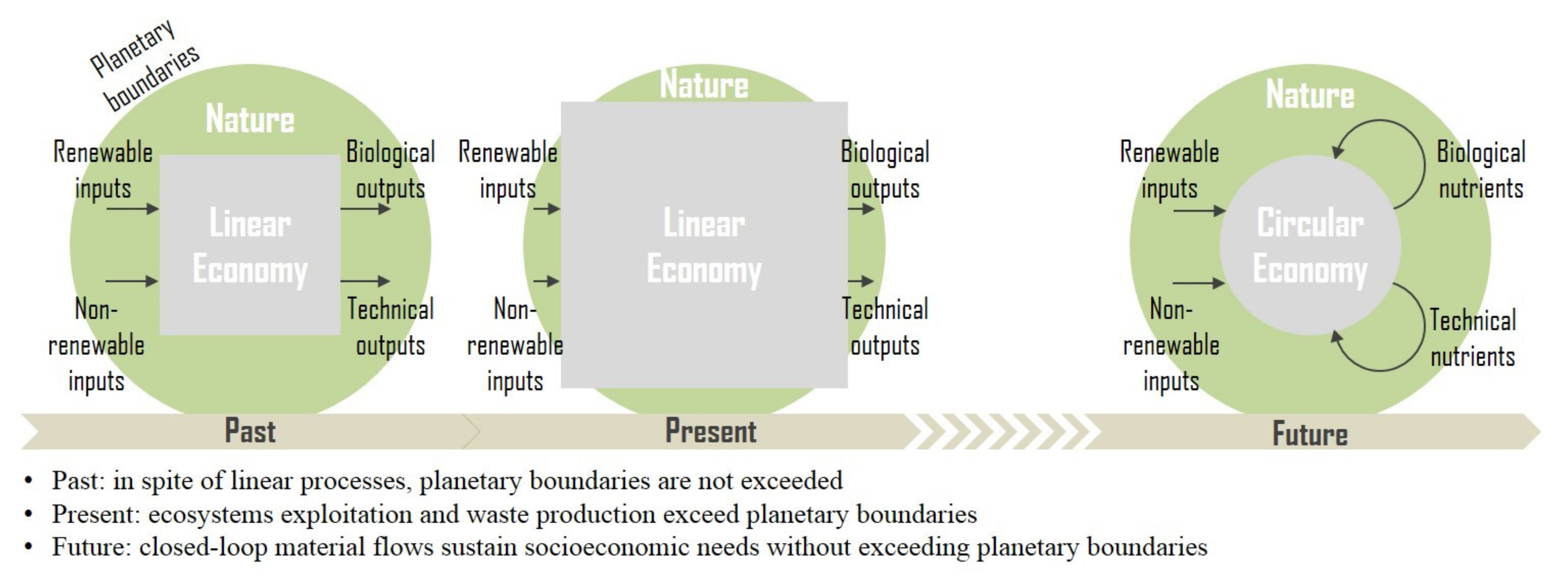
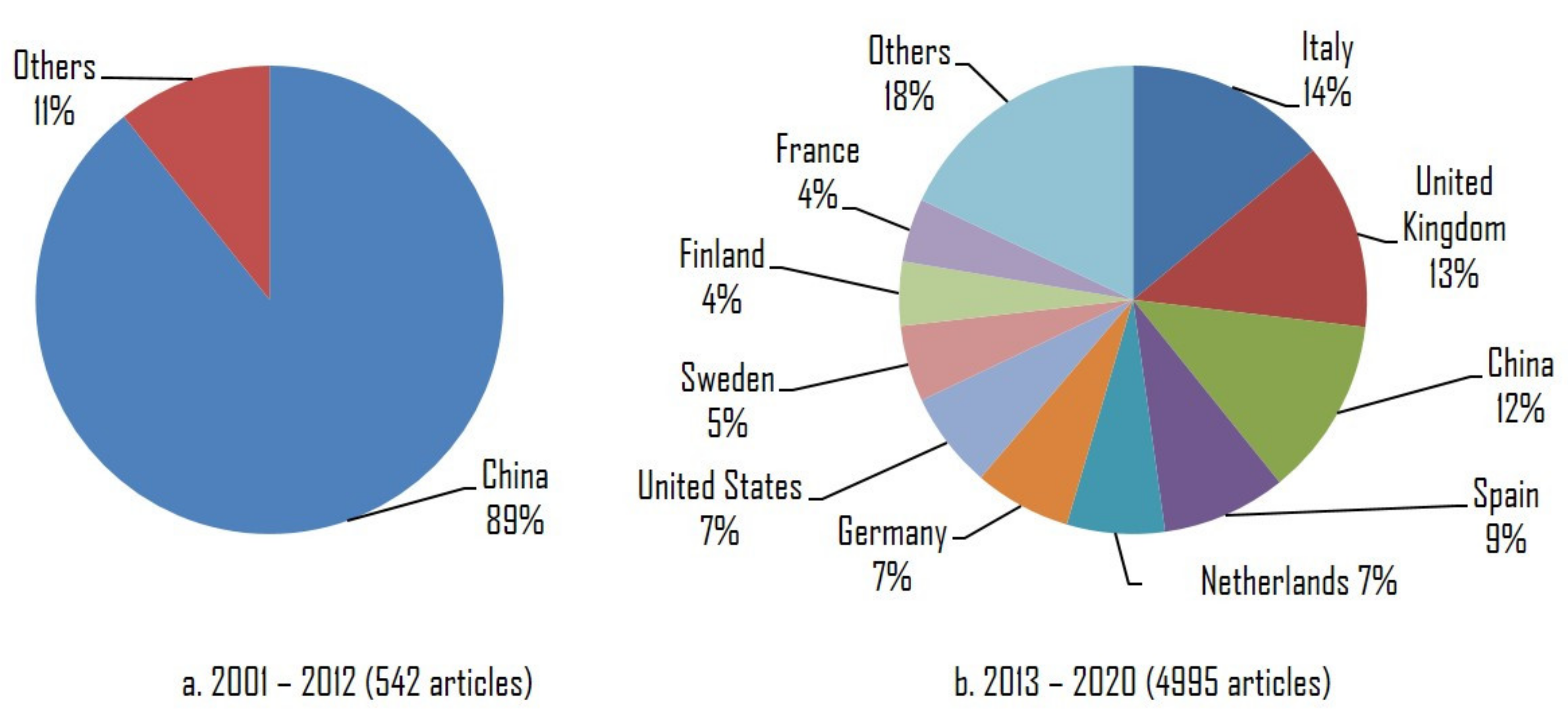

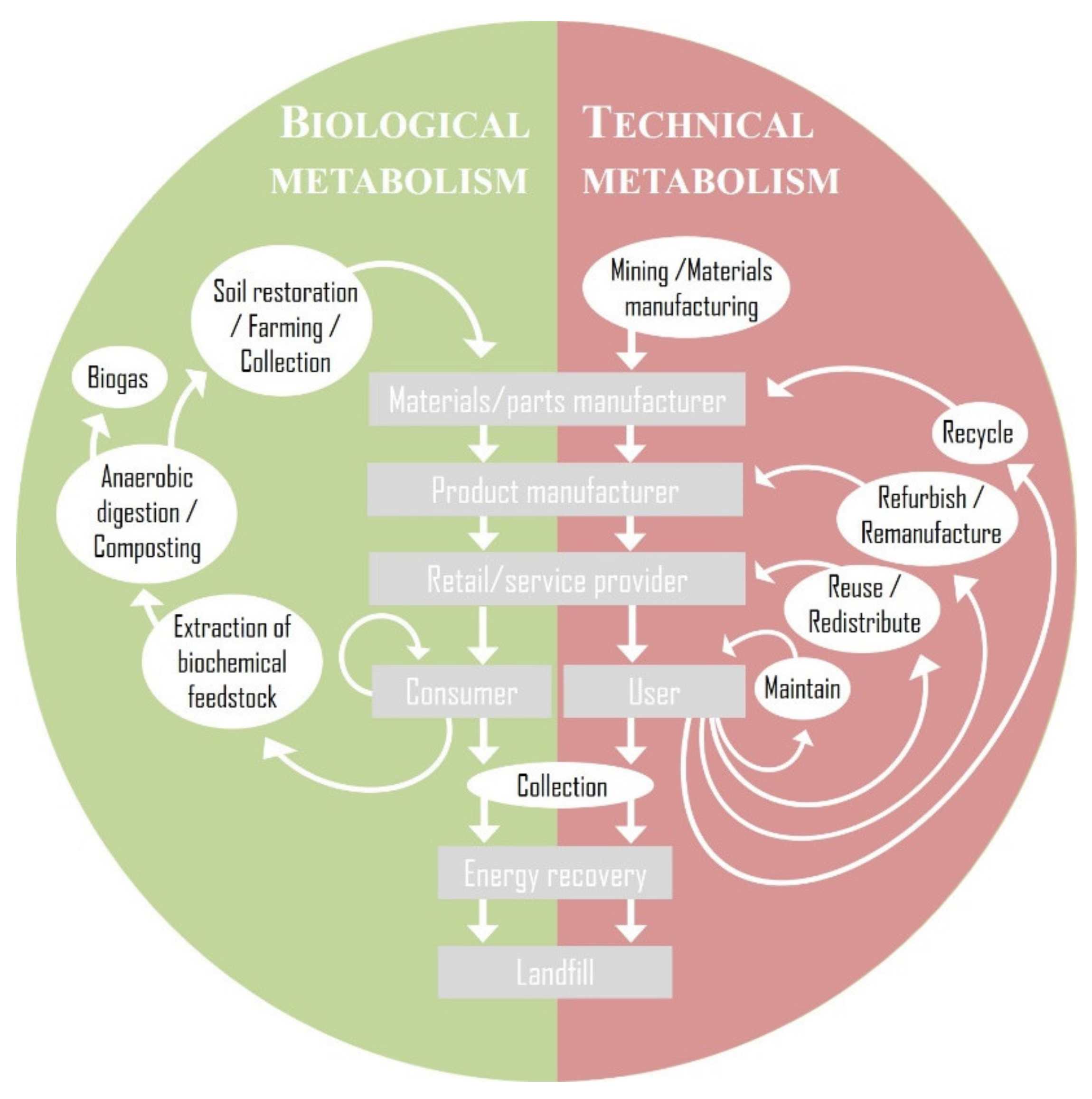
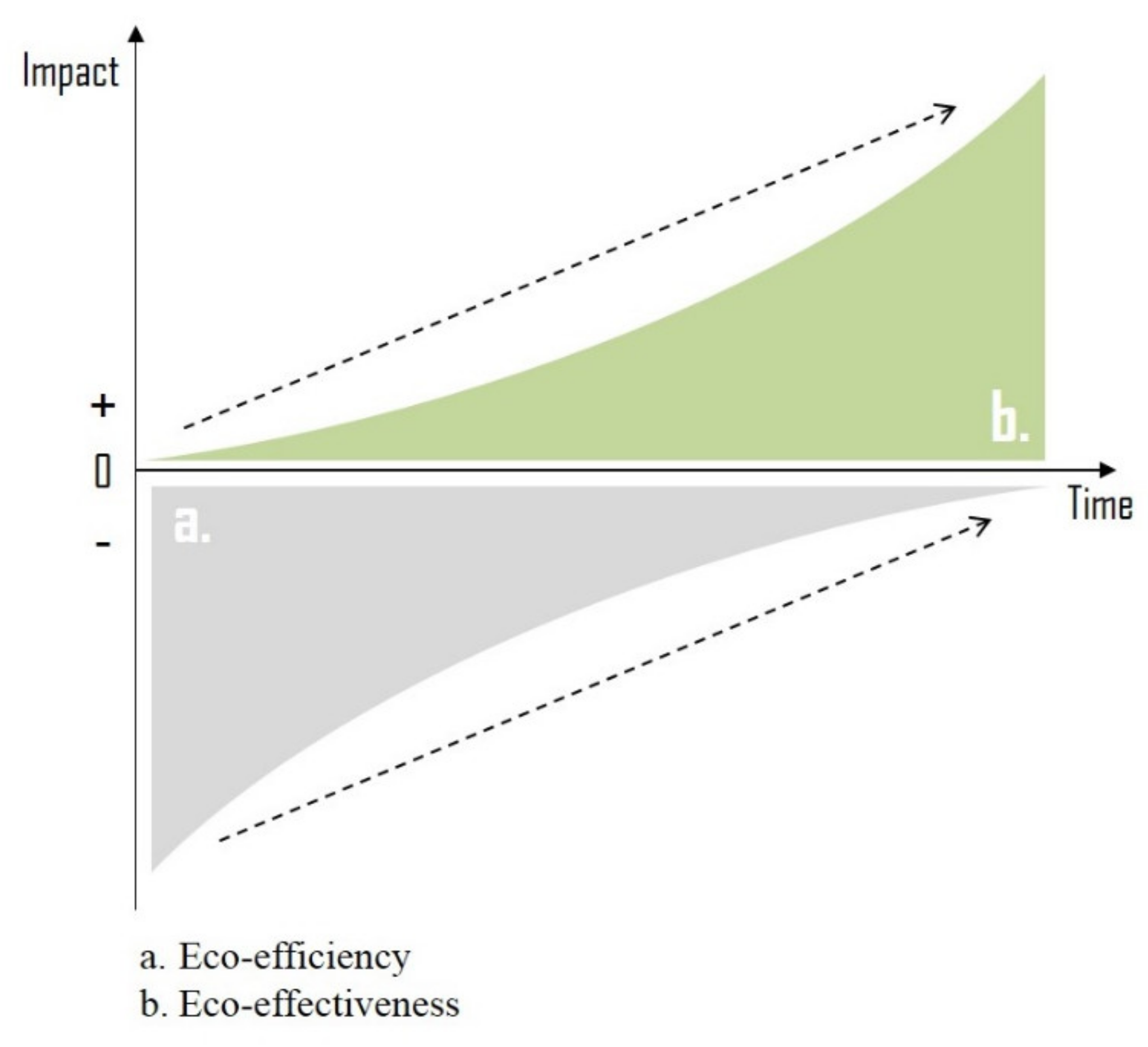
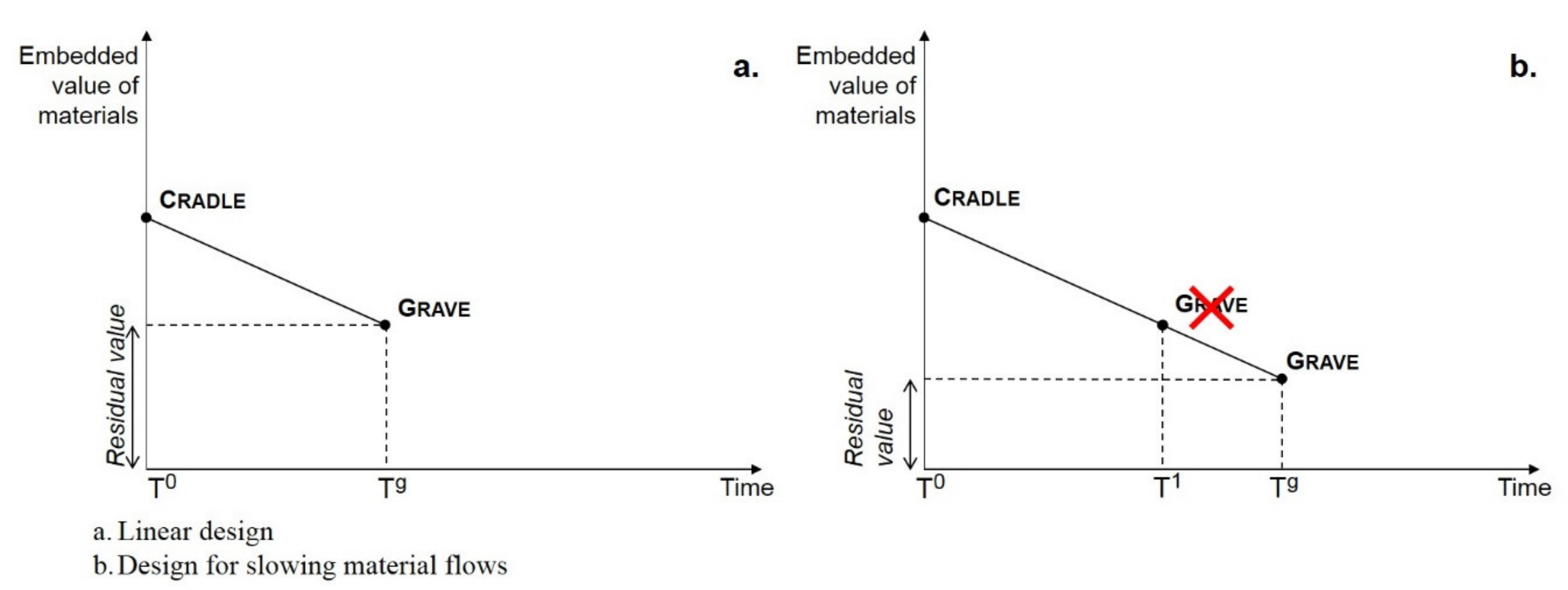
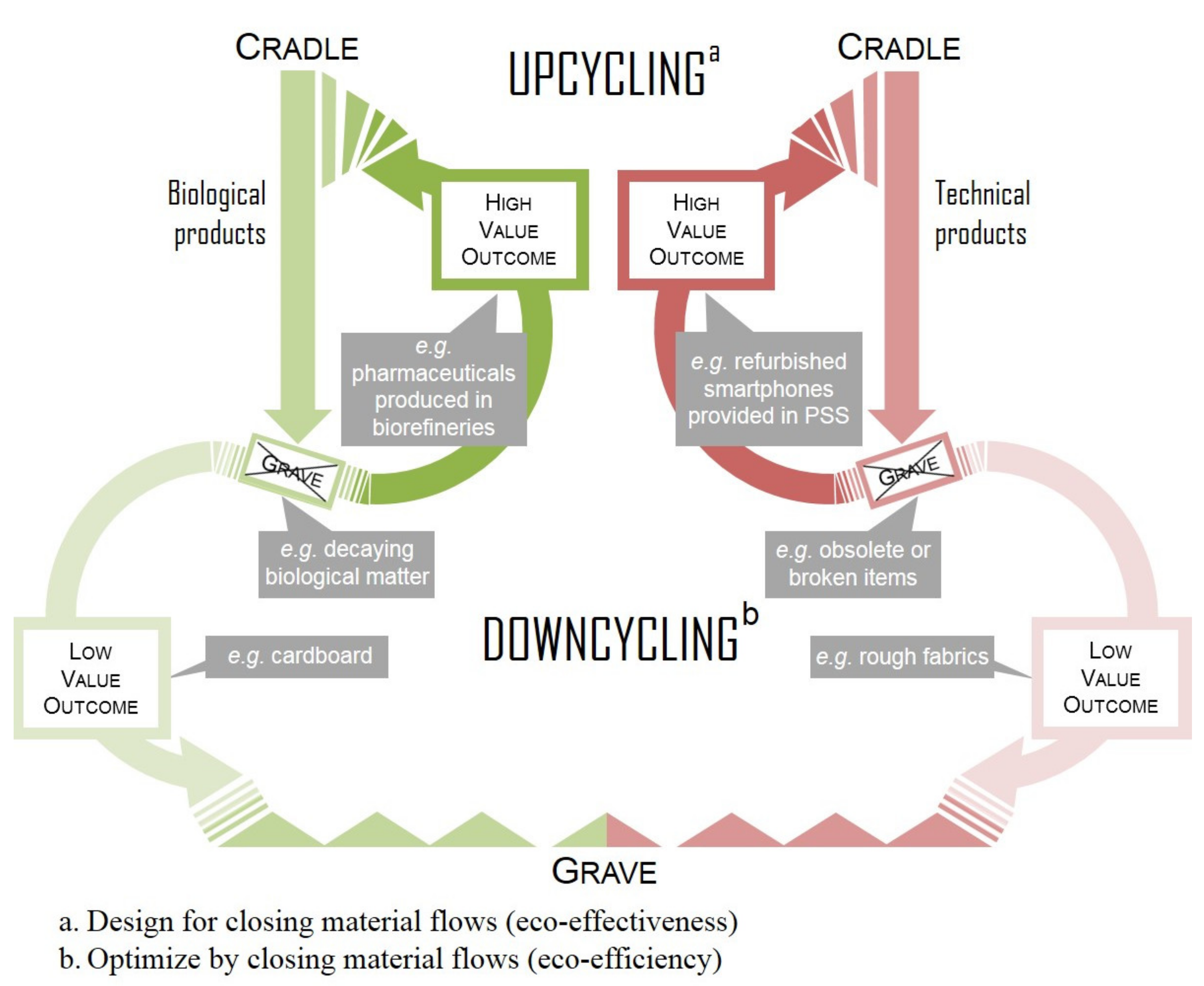
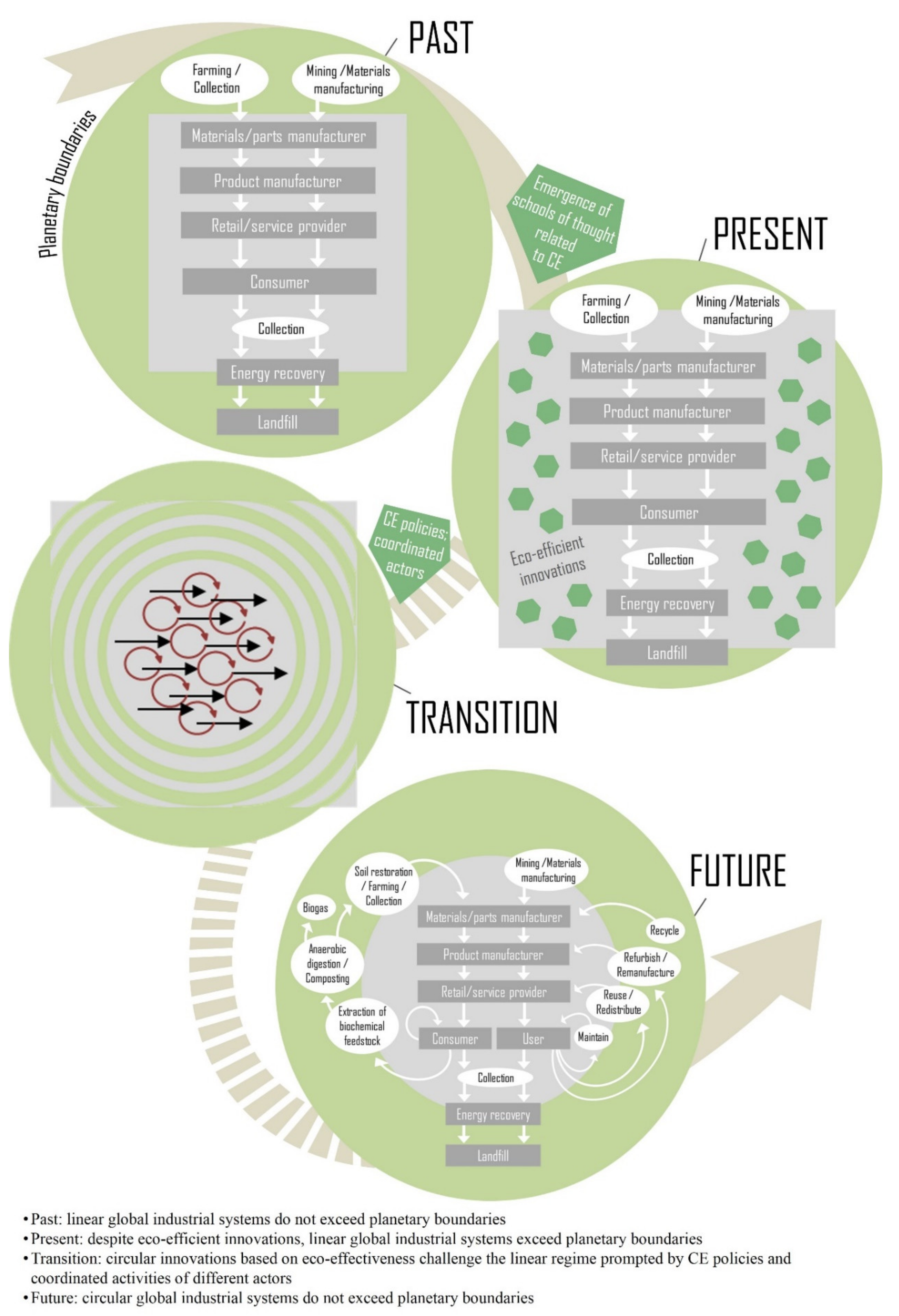
| Schools of Thought | Approach | Source | Type of Integration in the CE | Materials Involved |
|---|---|---|---|---|
| Industrial ecology, metabolisms, symbiosis, ecosystems and ecoparks | Models to analyze/design industrial systems by using ecological principles. Industries are assumed to form closed-loop networks requiring less external inputs and producing less wastes. | [18,28,29,57] | Conceptual and Operational | Biological and Technical |
| Laws of ecology | They are four: (1) Everything is connected to everything else; (2) Everything must go somewhere; (3) Nature knows best; and (4) There is no such thing as a free lunch. | [20] | Conceptual | Biological and Technical |
| Performance economy | Competitiveness achieved by means of a full shift to servitization. It maximizes the value obtained from using stock of resources, internalizes costs and risks associated to waste production. | [21,22] | Conceptual and Operational | Biological and Technical |
| Permaculture | Creating agro-ecological systems based on regenerative agriculture, natural resiliency, and evolutionary principles. | [25] | Operational | Biological |
| The Natural Step | A framework for decision-making in complex systems, to adopt sustainable development strategies by means of collaboration on individual, organizational and multistakeholder system levels. | [26] | Conceptual and Operational | Biological and Technical |
| Regenerative design | System design based on restoration and renewal of natural resources. | [24] | Conceptual and Operational | Biological and Technical |
| Natural capitalism | Improving profits and facing competitiveness by increasing the productivity of natural resources. | [27] | Conceptual and Operational | Biological and Technical |
| Cradle-to-cradle | Product design based on viewing materials as nutrients circulating in closed-loop metabolisms. | [17] | Conceptual and Operational | Biological and Technical |
| Biomimicry | Using nature and life principles as model to design products, processes, and systems. | [19] | Conceptual | Biological and Technical |
| Product-service systems | “[…] a mix of tangible products and intangible services designed and combined so that they are jointly capable of fulfilling final customer needs.” | [62] (p. 1552), [55] | Operational | Technical |
| Cleaner production | “[…] rooted in improvements in production efficiency, reductions in risks and improvements in resource productivity, is a unifying concept that can be used to help resolve the conflict traditionally seen between achieving industrial and economic growth and preserving the environment and human health.” | [54 (p. 186)] | Conceptual | Biological and Technical |
| Biorefineries | The adoption of different biotechnologies for the production of (bio-based) goods, services, or energy from biomass. | [56] | Operational | Biological |
| Blue Economy | Running industrial processes and tackle deriving environmental problems, shifting from the exploitation of resources to the adoption of clean technologies. | [23] | Conceptual | Biological and Technical |
| Country | Document Title | Publication Date |
|---|---|---|
| Finland | Leading the cycle—Finnish road map to a circular economy 2016–2025 | 09/2016 |
| Netherlands | A Circular Economy in the Netherlands by 2050 | 09/2016 |
| Germany | German Resource Efficiency Programme II: Programme for the sustainable use and conservation of natural resources | 11/2016 |
| Italy | Towards a Model of Circular Economy for Italy—Overview and Strategic Framework | 11/2017 |
| Portugal | Leading the transition: A circular economy action plan for Portugal | 12/2017 |
| Greece | National Action Plan on Circular Economy | 02/2018 |
| France | Circular Economy roadmap of France: 50 measures for a 100% circular economy | 04/2018 |
| Slovenia | Roadmap towards the Circular Economy in Slovenia | 05/2018 |
| Luxembourg | Luxembourg’s National Waste and Resource Management Plan | 06/2018 |
| Refinement | N (Limit to Subject Area) | N (Exclude Other Subject Areas) |
|---|---|---|
| Environmental Science | 2680 | 622 |
| Engineering | 1957 | 482 |
| Energy | 1369 | 143 |
| Business, Management, and Accounting | 1062 | 99 |
| Social Sciences | 848 | 76 |
| Economics, Econometrics, and Finance | 478 | 40 |
| Materials Science | 475 | 65 |
| Computer Science | 451 | 68 |
| Chemical Engineering | 431 | 57 |
| Agricultural and Biological Sciences | 398 | 142 |
| Chemistry | 324 | 38 |
| Earth and Planetary Sciences | 304 | 92 |
| Decision Sciences | 236 | 17 |
| Biochemistry, Genetics, and Molecular Biology | 146 | 9 |
| Physics and Astronomy | 140 | 26 |
| Mathematics | 133 | 1 |
| Medicine | 74 | 3 |
| Arts and Humanities | 59 | 7 |
| Pharmacology, Toxicology, and Pharmaceutics | 44 | 3 |
| Immunology and Microbiology | 43 | 2 |
| Multidisciplinary | 43 | 39 |
| Health Professions | 6 | 0 |
| Nursing | 5 | 0 |
| Psychology | 5 | 0 |
| Veterinary | 3 | 0 |
| Neuroscience | 2 | 0 |
| TOTAL | 5537 | |
© 2020 by the authors. Licensee MDPI, Basel, Switzerland. This article is an open access article distributed under the terms and conditions of the Creative Commons Attribution (CC BY) license (http://creativecommons.org/licenses/by/4.0/).
Share and Cite
Borrello, M.; Pascucci, S.; Cembalo, L. Three Propositions to Unify Circular Economy Research: A Review. Sustainability 2020, 12, 4069. https://doi.org/10.3390/su12104069
Borrello M, Pascucci S, Cembalo L. Three Propositions to Unify Circular Economy Research: A Review. Sustainability. 2020; 12(10):4069. https://doi.org/10.3390/su12104069
Chicago/Turabian StyleBorrello, Massimiliano, Stefano Pascucci, and Luigi Cembalo. 2020. "Three Propositions to Unify Circular Economy Research: A Review" Sustainability 12, no. 10: 4069. https://doi.org/10.3390/su12104069
APA StyleBorrello, M., Pascucci, S., & Cembalo, L. (2020). Three Propositions to Unify Circular Economy Research: A Review. Sustainability, 12(10), 4069. https://doi.org/10.3390/su12104069






